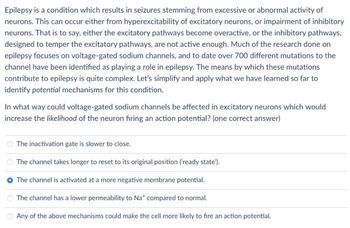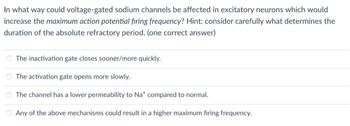
Human Anatomy & Physiology (11th Edition)
11th Edition
ISBN: 9780134580999
Author: Elaine N. Marieb, Katja N. Hoehn
Publisher: PEARSON
expand_more
expand_more
format_list_bulleted
Concept explainers
Question
Explain both question with proper explanation with step by step answer.

Transcribed Image Text:Epilepsy is a condition which results in seizures stemming from excessive or abnormal activity of
neurons. This can occur either from hyperexcitability of excitatory neurons, or impairment of inhibitory
neurons. That is to say, either the excitatory pathways become overactive, or the inhibitory pathways,
designed to temper the excitatory pathways, are not active enough. Much of the research done on
epilepsy focuses on voltage-gated sodium channels, and to date over 700 different mutations to the
channel have been identified as playing a role in epilepsy. The means by which these mutations
contribute to epilepsy is quite complex. Let's simplify and apply what we have learned so far to
identify potential mechanisms for this condition.
In what way could voltage-gated sodium channels be affected in excitatory neurons which would
increase the likelihood of the neuron firing an action potential? (one correct answer)
The inactivation gate is slower to close.
The channel takes longer to reset to its original position ('ready state').
The channel is activated at a more negative membrane potential.
The channel has a lower permeability to Nat compared to normal.
Any of the above mechanisms could make the cell more likely to fire an action potential.

Transcribed Image Text:In what way could voltage-gated sodium channels be affected in excitatory neurons which would
increase the maximum action potential firing frequency? Hint: consider carefully what determines the
duration of the absolute refractory period. (one correct answer)
The inactivation gate closes sooner/more quickly.
The activation gate opens more slowly.
The channel has a lower permeability to Na* compared to normal.
Any of the above mechanisms could result in a higher maximum firing frequency.
Expert Solution
This question has been solved!
Explore an expertly crafted, step-by-step solution for a thorough understanding of key concepts.
Step by stepSolved in 4 steps

Knowledge Booster
Learn more about
Need a deep-dive on the concept behind this application? Look no further. Learn more about this topic, biology and related others by exploring similar questions and additional content below.Similar questions
- Define monera.arrow_forwardGive typing answer with explanation and conclusionarrow_forwardGive an example of a specific function of necessary for life or reproduction in the human that is maintained by a feedback loop. Describe the system, giving the stimulus, the response, and how that maintains function of the system. describe a real or hypothetical condition caused by disruption of this system.arrow_forward
- Give one possible function of the observed phenomenon .arrow_forwardExplain well with proper step by step Answer.arrow_forwardCompare and contrast random and systematic experimental errors with specific examples either real or fictitious. Explain how these types of errors can be identified and reduced in an experiment.arrow_forward
arrow_back_ios
SEE MORE QUESTIONS
arrow_forward_ios
Recommended textbooks for you
 Human Anatomy & Physiology (11th Edition)BiologyISBN:9780134580999Author:Elaine N. Marieb, Katja N. HoehnPublisher:PEARSON
Human Anatomy & Physiology (11th Edition)BiologyISBN:9780134580999Author:Elaine N. Marieb, Katja N. HoehnPublisher:PEARSON Biology 2eBiologyISBN:9781947172517Author:Matthew Douglas, Jung Choi, Mary Ann ClarkPublisher:OpenStax
Biology 2eBiologyISBN:9781947172517Author:Matthew Douglas, Jung Choi, Mary Ann ClarkPublisher:OpenStax Anatomy & PhysiologyBiologyISBN:9781259398629Author:McKinley, Michael P., O'loughlin, Valerie Dean, Bidle, Theresa StouterPublisher:Mcgraw Hill Education,
Anatomy & PhysiologyBiologyISBN:9781259398629Author:McKinley, Michael P., O'loughlin, Valerie Dean, Bidle, Theresa StouterPublisher:Mcgraw Hill Education, Molecular Biology of the Cell (Sixth Edition)BiologyISBN:9780815344322Author:Bruce Alberts, Alexander D. Johnson, Julian Lewis, David Morgan, Martin Raff, Keith Roberts, Peter WalterPublisher:W. W. Norton & Company
Molecular Biology of the Cell (Sixth Edition)BiologyISBN:9780815344322Author:Bruce Alberts, Alexander D. Johnson, Julian Lewis, David Morgan, Martin Raff, Keith Roberts, Peter WalterPublisher:W. W. Norton & Company Laboratory Manual For Human Anatomy & PhysiologyBiologyISBN:9781260159363Author:Martin, Terry R., Prentice-craver, CynthiaPublisher:McGraw-Hill Publishing Co.
Laboratory Manual For Human Anatomy & PhysiologyBiologyISBN:9781260159363Author:Martin, Terry R., Prentice-craver, CynthiaPublisher:McGraw-Hill Publishing Co. Inquiry Into Life (16th Edition)BiologyISBN:9781260231700Author:Sylvia S. Mader, Michael WindelspechtPublisher:McGraw Hill Education
Inquiry Into Life (16th Edition)BiologyISBN:9781260231700Author:Sylvia S. Mader, Michael WindelspechtPublisher:McGraw Hill Education

Human Anatomy & Physiology (11th Edition)
Biology
ISBN:9780134580999
Author:Elaine N. Marieb, Katja N. Hoehn
Publisher:PEARSON

Biology 2e
Biology
ISBN:9781947172517
Author:Matthew Douglas, Jung Choi, Mary Ann Clark
Publisher:OpenStax

Anatomy & Physiology
Biology
ISBN:9781259398629
Author:McKinley, Michael P., O'loughlin, Valerie Dean, Bidle, Theresa Stouter
Publisher:Mcgraw Hill Education,

Molecular Biology of the Cell (Sixth Edition)
Biology
ISBN:9780815344322
Author:Bruce Alberts, Alexander D. Johnson, Julian Lewis, David Morgan, Martin Raff, Keith Roberts, Peter Walter
Publisher:W. W. Norton & Company

Laboratory Manual For Human Anatomy & Physiology
Biology
ISBN:9781260159363
Author:Martin, Terry R., Prentice-craver, Cynthia
Publisher:McGraw-Hill Publishing Co.

Inquiry Into Life (16th Edition)
Biology
ISBN:9781260231700
Author:Sylvia S. Mader, Michael Windelspecht
Publisher:McGraw Hill Education